New lease of life for the Banque Populaire maxi
Outside of the people who regularly get to sail AC72s, Yann Guichard is a sailor in one of the most enviable positions in our sport. Spindrift Racing, which he runs with Dona Bertarelli (Ernesto's sister), has recently acquired the 40m long former Banque Populaire maxi trimaran (now called Spindrift 2), adding to the La Trinite-sur-Mer based team’s existing MOD70 trimaran and Bertarelli’s D35 Ladycat, which it also manages.
Spindrift Racing’s season is understandably busy juggling three boats on race courses dotted around Europe. This kicks off with next month’s opening event of the D35’s Vulcain Trophy, the Open de Versoix National Suisse.
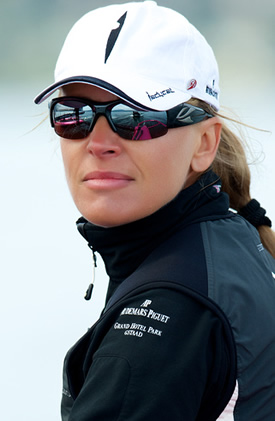
Dona Bertarelli helms Ladycat and the intention is for the team to complete the whole season on Lake Geneva, particularly hoping to re-create their 2010 success when Ladycat won Switzerland’s top event, the Bol d'Or Mirabaud and they will be looking to improve their third place finish in last year's Vulcain Trophy.
Guichard will be tactician on board Ladycat for the all the races he can make this year, but there will be some particularly interesting juggling to be done around the time of the Bol d’Or Mirabaud as it coincides with an in-port race in Lisbon during the Route des Princes, in which Spindrift Racing is campaigning its MOD70. Guichard says he will have a stunt double helming their black and white MOD70 for that, but will have to miss the two D35 Grand Prix prior to the Bold d’Or because of clashes with the Route des Princes. “It is difficult, but it is fantastic for me and the team. We have three fantastic boats and a big program for the next five years. It is good for the sailing world as well when you have someone like Dona who invests our sport, because it is so difficult at this time to find sponsors to build a good program. And if we hadn’t purchased the maxi tri Banque Populaire V, it would probably not be sailing.”
So a big hand to Dona Bertarelli and the team for keeping the pulse going on the world’s largest offshore racing trimaran, which at 140ft long is getting on for twice the size of an AC72, bigger even than the boats that raced in Valencia for the 33rd America’s Cup.
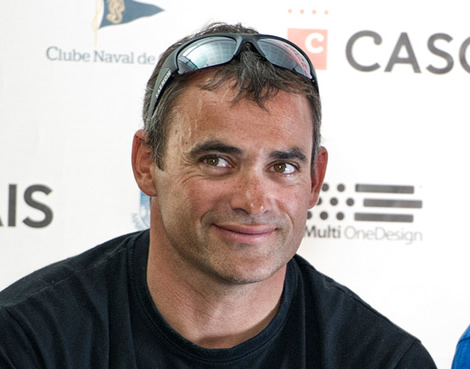
"It is a big, big boat and it is a big new project,” agrees Guichard. “We looked with Dona at all the different projects in sailing, especially in multihulls and the maxi tri was the most suitable for us. It is big, but you are really well protected on the boat. On the MOD70 you can capsize and you don’t have good protection. On the big boat it is far better, so for Dona that is perfect and I think she likes the challenge.”
Dona Bertarelli wants to learn to helm the monster trimaran and Guichard says that he is confident of her being able to achieve this. “She has a big capacity to work and we will build a fantastic team to be confident on board.”
One obvious candidate for a significant role on Spindrift 2 is Pascal Bidegorry, who competed as part of the Spindrift Racing MOD70 crew last season and who originally conceived Spindrift 2, as her first skipper. During Bidegorry's tenure Banque Populaire set a blazing new west to east Transatlantic record before the French bank replaced him with Loick Peyron for the Jules Verne Trophy. However according to Guichard at present it is too early to say who will be on board.
“We haven’t decided anything about the crew. For sure the MOD70 crew will be on board, and Pascal has got another project – he is doing the Transat Jacques Vabre with Safran. So we will see.”
This year the program for the monster tri is relatively light. She will take part in the Rolex Fastnet Race once again, in an attempt to cover the course in a better time than Peyron and his crew managed in 2011, when they won line honours but in reality had the Seb Josse-skipper Gitana XI and the MOD70s nipping rather too closely at their heels.
However the main objective for the year for Spindrift 2 is some training and to learn about the boat in order to finding possible ways to improve her.
When ready Dona Bertarelli and the team intend to take on a program of record breaking, which is what the 140ft long VPLP design was originally created to do. We can look forward to her undertaking an ‘Atlantic circuit’ taking in the Route of Discovery record, Miami-New York and the now extremely challenging west to east transatlantic record from New York to the Lizard, which this boat currently holds. And then ultimately a crack at the Jules Verne Trophy, the ultimate non-stop round the world record, which again this beast set at the beginning of 2012.
What remains uncertain is the time frame, says Guichard. “The goal is to break every record in the world, so for sure the Trophy Jules Verne will be in. But I cannot tell you now if it will be next year or the year after.”
Prior to embarking on the Atlantic circuit, this year they may try some shorter records, such as cross-Channel, currently held by Maiden 2 (at a leisurely 25.6 knots) or Round Britain (Oman Air Majan, 15.95 knots set in 2010 singlehanded by Sidney Gavignet).
As mentioned, Guichard is already contemplating ways of turboing the giant maxi-tri. Among the options are changing the rigging to a lighter weight composite alternative and also changing the mast, however he advises that may not involve going for a taller mast.
“On multihulls the battle is always to save weight and this boat is really big and weighs 25 tonnes, while Groupama 3 [confusingly now Banque Populaire’s Route du Rhum singlehander for Armel le Cleac’h] was 17. So it is a completely different boat. Perhaps the boat is not too big, but the mast may be too big for crossing the Atlantic when it is windy and you don’t need full mainsail.”
At present Spindrift 2’s mast is 47m tall, and replacing it with one shorter, with of course less rigging, smaller sails, etc could represent a substantial weight saving, Guichard muses. Changing to 3Di would represent a considerable weight saving. And then there is the crew. For the Jules Verne Trophy, Loick Peyron’s team comprised 12 and with food and gear, etc each represented around 200kg, so they might shed two... Guichard reckons they might be able to lose two tonnes or thereabouts without compromising the safety of the boat. “You don’t need to take any risks, because if you break something on this boat, you can kill someone, because it really is huge, everything is huge - the big genniker weighs close to 200kg, so you have to be careful.”
We half joke about getting Banque Populaire V foiling. She already is fitted with enlarged version of the curved foils in her floats, the forebears of the foils now being used on the AC72s. (Read our account of sailing on board the boat here).
“In the future it would be a good thing, but the boat was not built for that. You can see that Artemis [AC72] was not foiling at the beginning and now they want to foil, but I think it will be hard for them [in their first boat], because if it is not in the original plan it will be difficult. With this boat it is too ambitious too - you can work on the foils, not for foiling, but to improve, the efficiency of the foils. And you can work on the daggerboards. And because the boat sails at 40 knots, its aerodynamics are really important.”
At present the 40m tri is probably the only vessel capable of breaking her own Jules Verne Trophy record. With this there is an element of luck with the weather, but the team still wants to ensure it deals itself the best hand before leaving.
While bettering the Jules Verne Trophy record will be hard, the toughest record to beat is the west to east transatlantic which impressively is currently the fastest record in the WSSRC’s league table (despite being by no means the shortest) standing at an average speed (yes, average) of 32.94 knots for the 3 day 15 hour and 25 minute record.
Key to the transatlantic record is to do it on one weather system that is the right size and moving at the right speed so that the passage is a one-tacker – you start and finish on starboard tack. Because of this, Guichard wonders whether he shouldn't try to make the boat more asymmetric... “Perhaps you can move the mast on the right side – that would make a big performance boost.”
MOD70
The big events this year for the MOD70 are clockwise around Europe starting from Valencia in the Route des Princes, although as a warm-up the team will compete in the Tour de Belle Ile (rapidly becoming the French equivalent to the Round the Island Race), but is missing the ArMen race because it clashes with a D35 event. Finally in the autumn Guichard will compete doublehanded in the Transat Jacques Vabre aboard the MOD70, although he hasn’t chosen his crew yet, other than that it will certainly be someone within the team.
Guichard is of course concerned, as is everyone involved, that the MOD70 class doesn’t go the same way as its predecessor, ORMA. The class is currently on shaky ground after plans for a round the world race with stops came to nothing, leaving the class with a big hole in its calendar for 2013, although this has been filled by the Route des Princes and Transat Jacques Vabre.
“This is a transition year,” confirms Guichard. “It is difficult for everybody. Michel [Desjoyeaux] is doing the Figaro – that is bad news, because he hasn’t found any money to sail his MOD70. And MOD70 no2 [ex-Veolia] has been bought by an American. I don’t know if it is coming back into the circuit in 2014. It is a shame, because the boats are really nice.”
As to his confidence that the MOD70 class will be firing on all cylinders again in 2014, this he says depends on the management somehow securing some backing. Guichard acknowledges that this will be hard in the present economic climate. “Michel lost Foncia and Roland Jourdain lost Veolia - so that is two big teams that have gone, so it is difficult.” On a positive note, is the advent of the Route des Princes, a well-backed new race, while another Krys Ocean Race is already scheduled for 2014, but this time starting from Brest and heading for New York.
“The teams don’t want to leave, but if the program is not good, for sure some will leave and if we lose one more team, it is the end,” warns Guichard.
An issue that may well emerge will come in 2014 when there will be temptation for teams to enter their MOD70s in the Route du Rhum, France’s most important race after the Vendee Globe. The Route du Rhum is singlehanded and the MOD70 have deliberately not been conceived to be sailed shorthanded. In fact teams are making modifications to how their cockpits are set up in order to be able to sail them doublehanded in the Transat Jacques Vabre this season.
But a bigger issue for the MOD 70s in the Route du Rhum is that even in the multihull world size is everything and as Franck Cammas proved when he won the 2010 race in his 105ft Groupama 3 (now Banque Populaire), the MOD70s won't be able to compete for line honours and so will have to have their own class.
Guichard says that he hopes there is an alternative event to the Route du Rhum for the MOD70s .“I would prefer to have a really good fully crewed circuit like the original plan, but we will see. For sure if we don’t have an alternative, I cannot imagine leaving the boat in the shed in November 2014 while the most important race in France is taking place, even if it is not my goal to do the Route du Rhum with the MOD70.”
ACWS
In addition to his role at Spindrift Racing, Guichard has also been co-helmsman for the Peyron brothers Energy Team and was steering the French team’s AC45 in Naples last week. Like several of the teams involved with the America’s Cup World Series, but which didn’t manage to secure the budget to challenge for the 34th America’s Cup, Guichard bemoans the organisers chopping the number of ACWS events this season: “It is a shame because they planned to have four events, but there will be only one. I think it is a really great circuit, but it is difficult for teams to do the America’s Cup and work on their AC72 and on the AC45 at the same time.”
Unfortunately before the Naples event, Guichard says the French team didn’t have enough time to train, certainly compared to the full blown Cup teams. Despite this they had their moments, including a particularly good second day of racing when they equalled Oracle Team USA Slingsby in posting a 2-1 for the day.
At present, rather sadly, the future of the America’s Cup World Series depends entirely on the outcome of the 34th America’s Cup. One imagines that if Oracle Team USA successfully defend, then they will salvage the circuit for the 35th AC. Guichard is enthusiastic about it: “It would be a good thing to continue. It is a great boat and it is really spectacular and you can sail really close to the shore... I think it is a good circuit, like the Extreme Sailing Series, but you need more competition and more events – that would be great, but it depends if Oracle wins the Cup or not.”
Guichard says he is very impressed by not only the AC72s but the America’s Cup teams getting the large catamarans to foil so quickly. “In six months they’ve got the boats flying and that is the story with the Cup - it is really fantastic. I just put one foot in the Cup in the AC45 and it is incredible. For sure, there is a lot of money, the best guys from every discipline are there and everything move really fast - you can improve everything really quickly. Only in the Cup can you do that. The AC72s are amazing - they are sailing at 42-45 knots and upwind at 22 knots and they are trying to gybe and stay on the foils - it is crazy. The Cup will be a great spectacle for sure, but it is missing five or six boats for sure. Only three boats for the Louis Vuitton and the Italians only have one boat and two wings so if they capsize, it will be difficult. And the schedule for the Louis Vuitton Cup is really huge - 30 days of sailing. I think perhaps the winner will be the boat which stays up the right way...”
So will the incredible development in multihull technology seen in the 34th America’s Cup transfer to offshore multihulls in due course? Guichard says he’s sure it will - that is what the America’s Cup is all about: Things get created and tested there and then filter down. 3DL and 3Di sails for example were both originally created for America’s Cup campaigns. Guichard believes it will be a while before we start to success fully foiling, wing powered offshore multihulls, although Alain Thebault would certainly query the first part, particularly if L’Hydroptere’s attempt on the Transpac record is successful.
“We have to take it step by step for offshore races because they are completely different. It is not the same game, but it is complimentary for sure.”
One area where there is certainly lessons to be learned from the AC72 is in their foil development, perhaps not with a view to getting offshore multihulls airborne, but lifting more so than they are currently.
“Now we can move the foil a bit while we’re sailing, we can change the incidence but on the AC72s you can move everything in every direction! It is great, but in an offshore race you have to finish. It is not the same problem when, for sure you have to finish, but you stay in the Bay of San Francisco and you sleep in your bed at night! But everyone is learning. I saw the new sails on the AC72s - the apparent wind is so far in front that the sails are completely flat - it is crazy. So everything improves and everything moves on. It is a good thing for the sailing world. It would be a shame if the Cup goes back to monohulls.”

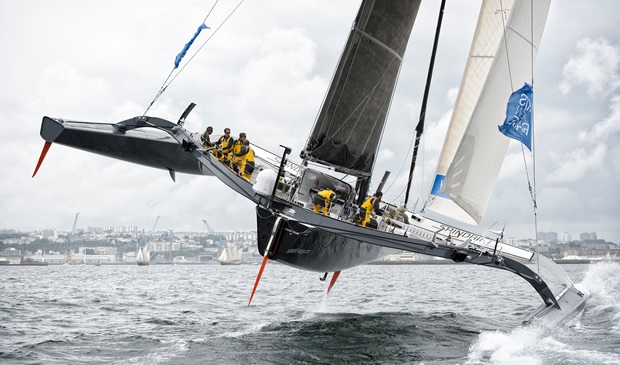
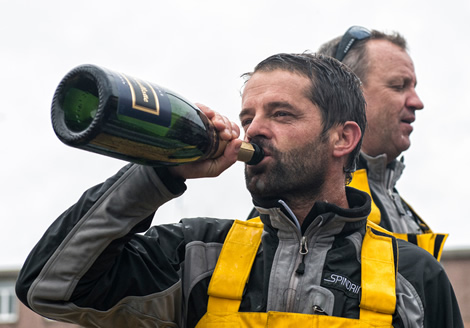
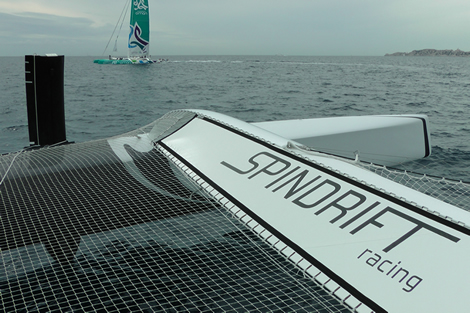
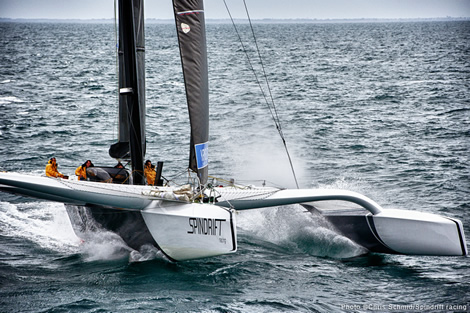
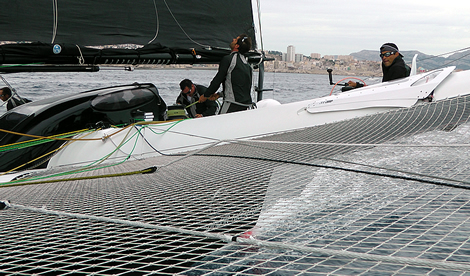
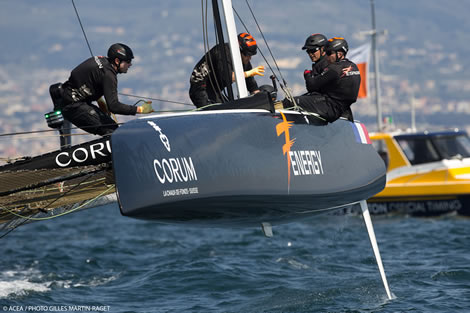
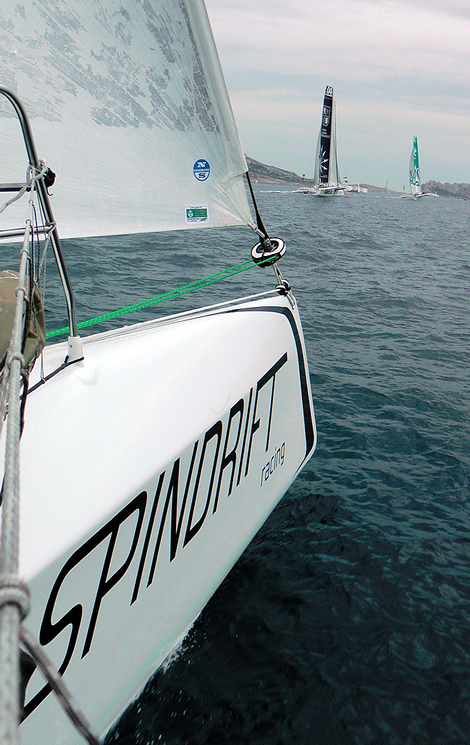








Latest Comments
Add a comment - Members log in